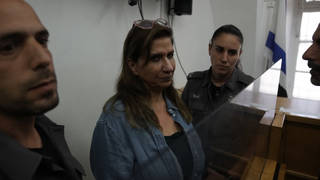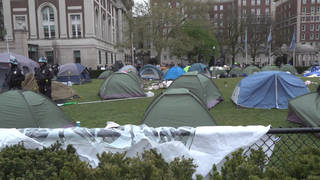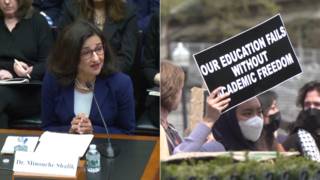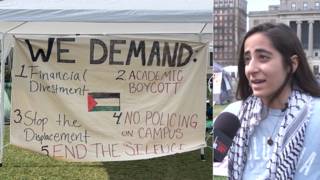
Related
Guests
- Al Sharptoncivil rights leader and MSNBC host.
As funerals begin for the victims, Al Sharpton, the civil rights leader and MSNBC host, reflects on the Charleston massacre and the renewed battle over the Confederate flag. This week South Carolina Governor Nikki Haley called for the flag’s removal from the state Capitol grounds, while Alabama Governor Robert Bentley took the flag down in his state. “It’s about 150 years too late,” Rev. Sharpton says. “Someone should have told them they lost the Civil War.”
More from this Interview
- Part 1: “The 9/11 of the Black Church”: Mourners Flock to SC as Funerals Begin for Emanuel Massacre Victims
- Part 2: “Slavery Deeply Embedded” in South Carolina: Emanuel AME Church on Street Named for Racist Lawmaker
- Part 3: Rev. Al Sharpton: Removing the Confederate Flag is Welcome–But 150 Years Too Late
- Part 4: 4 Decades After Burning Confederate Flag, SC Activist Brett Bursey Says the Struggle Goes On
- Part 5: After Walter Scott Murder & Church Massacre, “Black Lives Matter” Takes on Special Meaning in SC
- Part 6: Rev. Jesse Jackson: Take Down the Confederate Flag — and White Supremacist Culture with It
Transcript
AMY GOODMAN: We turn right now to Reverend Al Sharpton, who was standing here just a few minutes ago before the broadcast began, as I talked to him about what has taken place in South Carolina, the heart of the Confederacy.
AMY GOODMAN: Reverend Sharpton, your comments on this sacred day of one of the funerals?
REV. AL SHARPTON: Well, I think that this is a day that reminds us, despite all that we have seen, that we still have raw, violent racism in this country, terrorism. And the last time I saw Reverend Pinckney, here, not two months ago, where here, in Charleston, around the case of Scott, where I had come down, where our chapter of National Action Network had a prayer vigil at the scene Walter Scott was killed by police, and Reverend Pinckney did the prayer. I came back two months later to stand, last Thursday, the day after he was killed, in this sacred church.
And as I said at the funeral yesterday of Sharonda [Coleman-Singleton], that taking the flag down, without changing the policies, is not enough. Yes, we want the Confederate flag down. It should have never been up. But now Governor Haley and them, that were for the flag, are against the flag. And I said to her that she only knew me from looking out the window protesting. She said, “Oh, I would have hugged you if you’d come inside.” We don’t want just a hug. We want to deal with voting rights, police reform. We still have not gone to trial on the Scott case in this state. There’s no hate crime bill in this state. We still must deal with Medicaid. So I think that the reality is that the climate that this young terrorist felt justified in is still among us.
AMY GOODMAN: What about the fact that FBI Director James Comey came out right away and said that this was not terrorism?
REV. AL SHARPTON: If this is not terrorism, then what is terrorism? To go in a church and sit an hour and wait to shoot multiple people, including an elected official, is terrorism by any definition.
AMY GOODMAN: Do you think Governor Haley could have taken down the flag on her own?
REV. AL SHARPTON: I think that Governor Haley could have and should have taken it down on her own. And if there was some legal statute, she should have removed it and had them challenge and let them be the guilty party.
AMY GOODMAN: Your comments on the Republican governor of Alabama, who took it down?
REV. AL SHARPTON: I think that it was good, but it was about 150 years too late. My mother was born and buried in Alabama. Somebody should have told them they lost the Civil War, at least that part of it. The flag is not only a flag of racism and lynching and slavery, it’s a flag of treason. These are people that challenged the government of the United States and tried to overthrow Abe Lincoln’s government.
AMY GOODMAN: What do you say to those who say this is about heritage, not hate?
REV. AL SHARPTON: It’s a heritage of slavery. It’s a heritage of lynching. It’s a heritage of we are less than human. They want to be proud of that heritage? Fine. But you don’t put it up on a public square where taxpayers fund it and subsidize it.
AMY GOODMAN: Do you think it’s possible that Dylann shot the roof off of the Confederacy?
REV. AL SHARPTON: I think that it is possible Dylann shot the roof off of the Confederacy. What I don’t want to see is the Confederates get away with just changing the curtains in the window rather than the structure of the building.
AMY GOODMAN: Reverend Sharpton, you’re standing in front of Mother Emanuel, the Emanuel AME Church, but you are standing on Calhoun Street. And just down the road is a statue of the former U.S. vice president, John Calhoun, known for his pro-slavery stance, saying slavery is good.
REV. AL SHARPTON: These are signs of the celebratory way that those that advanced slavery and lynching, those that advanced treason, have been treated in the South—and in the North. In Brooklyn, New York, at Fort Hamilton, is a Robert E. Lee Street, the general of the Confederate Army. So, we have got to stop romanticizing and trying to justify, in the name of heritage, people that were outright committing treason and had a quest—and, in fact, made their quest a reality—of enslaving people that became American citizens and were brought here to build this country on the backs of slaves.
AMY GOODMAN: We just talked to a Charleston resident who said he started a petition to rename Calhoun Street, here in front of Mother Emanuel, Reverend Pinckney Street. Your thoughts?
REV. AL SHARPTON: My thoughts is that that would be wonderful. I would celebrate that. Nothing would be greater than to change it from Calhoun, who advocated Confederacy, to Reverend Pinckney, who advocated liberation. But then we have to change the policies that are conducted on the street.
AMY GOODMAN: And finally, the Black Lives Matter movement, “Black Lives Matter” being put on Confederate statues, your thoughts?
REV. AL SHARPTON: I think that is wonderful, because I think the Confederacy was that black lives don’t matter. And I think what is really the most inspiring thing I’ve seen since Reverend Pinckney was killed is when I saw young white kids in the Deep South holding up signs saying “Black Lives Matter.”
AMY GOODMAN: That was the Reverend Al Sharpton, the Reverend Al Sharpton, earlier this morning in front of Mother Emanuel. And as we broadcast today, the casket of Reverend Clementa Pinckney has just been brought out by a state police honor guard, his casket covered with flowers, as they solemnly descended the stairs of Mother Emanuel. See, the first floor of the church is called the basement, and that’s where the Bible study took place two Wednesdays ago, that the accused shooter, Dylann Roof, was a part of, and then, after an hour, allegedly opened fire, killing nine of the parishioners who were at Bible study. Upstairs is the chapel, where Reverend Pinckney lay in state. The funeral will take place at College of Charleston arena, the TD Arena, because it was believed that so many—and clearly it’s true, because thousands gathered for the hours yesterday to see Reverend Pinckney, to pay last respects yesterday. I believe the arena holds something like 5,400 people. There are many expected who will be outside.















Media Options